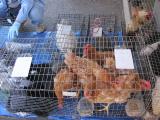Apr 5, 2013 (CIDRAP News) – US health officials said today they are working on a potential vaccine and diagnostic tests for the novel H7N9 influenza strain in China and are warning clinicians to be alert, but they emphasized that they see no signs that the virus is spreading from person to person.
At a news teleconference this afternoon, Centers for Disease Control and Prevention (CDC) officials said the agency and vaccine manufacturers are developing a vaccine seed strain for the virus in case it starts spreading widely. The CDC also sent an advisory to clinicians today urging them to watch for possible cases in travelers returning from China.
CDC Director Tom Frieden, MD, MPH, said Chinese public health officials have reported 16 human cases as of today, with six deaths, from four provinces. Fifteen cases have been in adults, with ages ranging from 27 to 87, and one patient, a 4-year-old child, has an apparently mild illness.
The source of the virus has not been conclusively determined, but Chinese officials said yesterday that they found it in pigeons, and today they reported finding it in chickens.
Frieden said there has been "no person-to-person transmission and no epidemiologic link between any of the cases so far." But he added, "There are two families where there was illness in the family around the time of a confirmed case, and those situations are being investigated by Chinese authorities to see if there was person-to-person transmission."
He said that with a contagious flu virus, you would expect to find 20 or 30 cases among 100 close contacts of an infected person, but none have been found in the Chinese contact investigations so far. "In addition, many or most of the cases have direct contact with live poultry," he added.
The CDC has already developed an H7N9 diagnostic test that the agency can use on travelers with suspicious illnesses, Frieden said. The agency also will develop a diagnostic test kit that it can provide to the states and also to Chinese officials to permit rapid diagnosis, he added.
Information from China suggests that the virus is sensitive to the two main flu antivirals, oseltamivir (Tamiflu) and zanamivir (Relenza), though that remains to be confirmed, he said.
Also, the CDC and manufacturers are "developing a candidate virus that could be used to produce a vaccine if one was needed. This will be done only if there is widespread transmission," Frieden said.
The Chinese government has deposited the full genetic sequence for samples of the H7N9 virus in an open database. Since they don't have an isolate of the virus yet, the CDC and manufacturers are using the genetic data to make a vaccine seed strain through reverse genetics, Frieden said.
At the briefing, Michael Shaw, PhD, associate laboratory director in the CDC's Influenza Division, said the agency is making the seed strain with synthetic genes that were created under a contract with the Biomedical Advanced Research and Development Authority (BARDA) of the US Department of Health and Human Services.
"Many different companies and organizations are working on this, to make a strain that would be shared as widely as possible," he said.
Shaw predicted it would take at least a month to create the seed vaccine, according to a New York Times story published yesterday.
H7 viruses have been known to infect humans before, typically causing only mild illness, and CDC officials said the agency already has candidate vaccines for several of those. But because this novel H7N9 is very different from those strains, the vaccines are not likely to be protective, Frieden said today.
Shaw told CIDRAP News that the CDC has candidate vaccines for H7N1, H7N2, H7N3, and H7N7 viruses, some of which the agency made and some of which were produced by other labs in the World Health Organization's network.
Making flu vaccine seed strains using reverse genetics is nothing new, as 29 approved vaccine candidates have been made in this way, Shaw said. Those include 22 H5 vaccines, three H9, and four H7.
When H7N9 isolates become available, the CDC will also try using them to make a candidate vaccine, Shaw said. "Nothing will be left to chance, so conventional reassortment will be attempted," he commented. He referred to the fact that making a flu vaccine involves combining surface proteins from the target virus with a backbone of internal proteins from another flu virus that is known to grow well in eggs.
In response to questions at the briefing, Frieden said, "There is not population immunity to this strain. And there is no specific way to say exactly what it would take to become better adapted" so that it would spread from person to person.
The CDC is not issuing any travel advisories, but Frieden repeated the agency's long-standing advice that tourists should avoid birds in live markets.
In its e-mailed health advisory to clinicians today, the CDC said they should consider the possibility of a novel H7N9 infection in persons with an appropriate travel or exposure history. Although most of the cases have been severe and involved adults, the virus may cause mild illness and can infect children, the agency said.
Suspected infections in the United States should be reported to the CDC within 24 hours of first detection, and state health departments should notify the CDC promptly of all patients under investigation for possible infection, the advisory said.
It also advised that all unsubtypeable influenza A virus specimens should be turned over to the CDC for further testing, since the agency is doing all confirmatory testing at this point.
See also:
Apr 5 CDC health advisory to the Health Alert Network
Apr 4 New York Times story about candidate vaccine


















